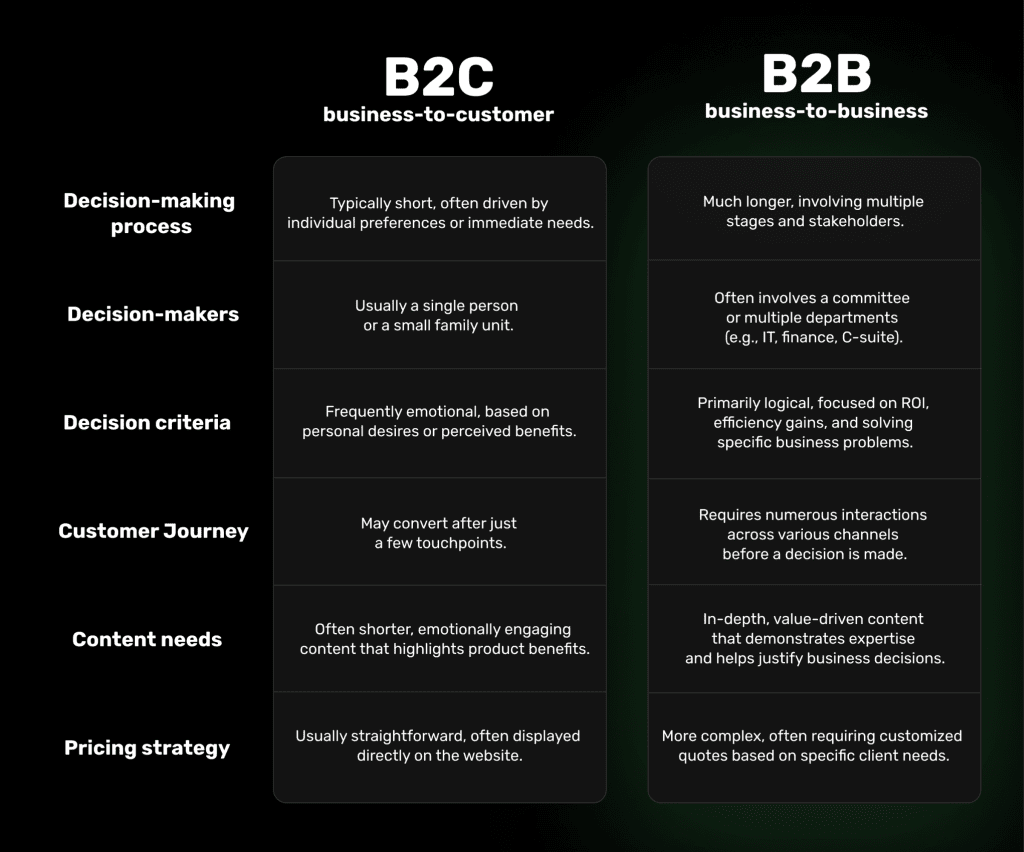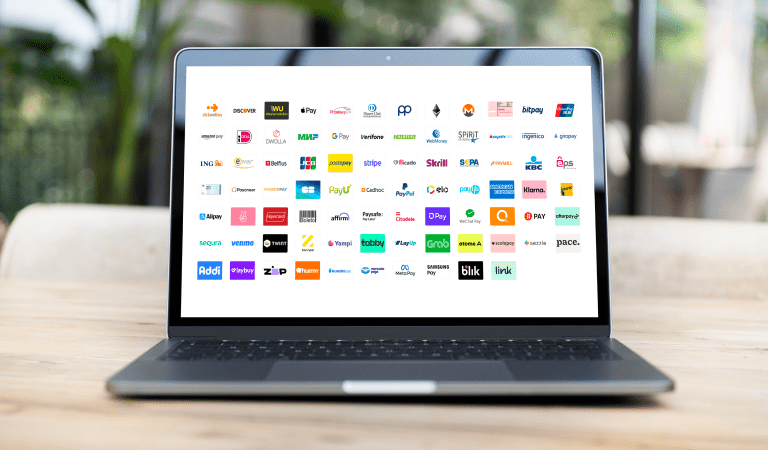How to create a great B2B service website: a comprehensive guide
Publication date: 17.10.2024
Last updated: 17.10.2024

In today’s digital-first business environment, a strong online presence is not just an asset—it’s a necessity for B2B service companies. Your website serves as the digital face of your organization, often forming the first impression for potential clients and partners. This comprehensive guide will walk you through the essential elements and strategies needed to create a B2B service website that not only impresses visitors but also drives meaningful business results.
Understanding the B2B website landscape
Before we dive into the specifics of creating an outstanding B2B service website, it’s crucial to understand how B2B websites differ from their B2C counterparts. This understanding will inform every decision you make in your website’s design and content strategy.
Key differences between B2C and b2b websites

Understanding these differences is crucial because they influence every aspect of your B2B website, from design and user experience to content strategy and lead nurturing processes.
1. Developing a strong visual identity
Your website’s visual appeal plays a pivotal role in communicating the quality of your services and establishing your brand in the minds of potential clients. Here’s how to create a strong visual identity that resonates with a B2B audience:
Create a Key Visual
A key visual is the central element of your visual identity that encapsulates your brand’s essence. It should be versatile enough to use across various digital touchpoints while remaining instantly recognizable.
Steps to develop a Key Visual:
- Identify your brand’s core values and unique selling propositions.
- Translate these concepts into visual elements (shapes, colors, imagery).
- Create multiple variations and test them with your target audience.
- Refine based on feedback and ensure it works across different mediums (web, print, social media).
Ensure consistency across your digital presence
Consistency in design builds trust and reinforces brand recognition. Apply your key visual and overall design aesthetic consistently across:
- Website homepage and all internal pages
- Email templates
- Corporate presentations
- Social media profiles and content
- Digital ads and banners
- Downloadable resources (e.g., whitepapers, case studies)
💡 Pro Tip: Create a comprehensive brand style guide that outlines the use of your key visual, color palette, typography, and other design elements to ensure consistency across all touchpoints.
Balance aesthetics and functionality
While an aesthetically pleasing design is important, it should never come at the cost of functionality, especially for a B2B audience that values efficiency and clarity.
Key considerations:
- Use a clean, uncluttered layout that guides the user’s eye to important information.
- Ensure easy navigation with a logical menu structure and clear labeling.
- Optimize for fast loading times, as B2B decision-makers often research during busy work hours (by the way, the speed of website operation is always of great importance)
- Implement responsive design to provide a seamless experience across devices.
First impressions matter
Your homepage is often the first point of contact between your brand and potential clients. Make it count by:
- Clearly communicating your value proposition above the fold.
- Using high-quality, relevant imagery that reflects your industry and target audience.
- Incorporating subtle animations or micro-interactions to engage visitors without overwhelming them.
- Ensuring fast load times to prevent bounce rates.
Example: HubSpot’s homepage effectively combines a clean design with clear messaging, immediately communicating their value proposition and guiding visitors to relevant resources or product information.
2. Crafting a coherent business narrative
After establishing a strong visual identity, it’s crucial to weave a compelling and consistent narrative throughout your website. This narrative should clearly communicate your business’s value proposition, expertise, and unique selling points.
The power of storytelling in B2B websites
It’s paramount to tell a coherent story about your business and the services you offer throughout your website. This narrative should seamlessly connect different sections of your site, creating a compelling and memorable user experience that clearly demonstrates your value and expertise.
Here’s how to create and implement this narrative:
1. Define your core message
- Clearly articulate what makes your company unique in your industry.
- Identify the key benefits you provide to clients.
2. Align your services with client needs
- Explain how each of your services addresses specific client pain points or challenges.
- Use language that resonates with your target audience, avoiding jargon unless necessary.
3. Showcase your expertise
- Highlight your company’s areas of specialization.
- For example: “We are the industry leaders in [specific services], as evidenced by our numerous awards [link to awards section] and successful case studies [link to case studies section].”
4. Leverage social proof
- Integrate client testimonials and success stories throughout your site to support your claims.
- For instance: “Our expertise, honed through working with industry giants [showcase client logos], has positioned us as trusted advisors in the field.”
5. Demonstrate thought leadership
- Highlight your team’s contributions to industry knowledge.
- Example: “We share our experience gained from working with clients at various conferences and industry events [include photos or videos of your employees’ presentations].”
6. Create a consistent thread
- Ensure that your narrative is consistent across all pages of your website.
- Use similar language and messaging in your About Us page, service descriptions, case studies, and blog posts.
7. Use visual elements to support your story
- Incorporate infographics, timelines, or other visual elements that illustrate your company’s journey, growth, or impact in the industry.
8. Personalize the narrative
- Tailor aspects of your story to different audience segments when possible.
- Consider creating industry-specific landing pages that contextualize your services for different sectors.
By crafting and maintaining a coherent narrative throughout your website, you create a more engaging and persuasive user experience. This approach helps potential clients understand not just what you do, but why you’re the best choice for their needs, increasing the likelihood of conversion.
3. Incorporating credibility builders
In the B2B space, where decisions often involve significant investments and long-term partnerships, building credibility is paramount. Your website should serve as a trust hub, showcasing evidence of your expertise, reliability, and success.
Testimonials: the power of social proof
Testimonials provide potential clients with real-world validation of your services. To maximize their impact:
- Feature diverse testimonials representing various industries and company sizes you serve.
- Include the client’s name, position, company, and if possible, a photo to add authenticity.
- Highlight specific results or benefits the client achieved through your services.
- Consider video testimonials for added engagement and credibility.
Awards & Certifications: third-party validation
Industry recognition reinforces your expertise and quality of service. Showcase your achievements by:
- Creating a dedicated “Awards & Recognition” section.
- Featuring award logos in your website’s footer across all pages.
- Highlighting recent or significant awards in your homepage banner or sidebar.
💡 Pro Tip: Don’t just list awards; briefly explain what each award recognizes to provide context for potential clients who may not be familiar with industry-specific accolades.
Partnerships & Affiliations: strength in association
Highlighting your relationships with respected organizations can significantly boost your credibility. Consider:
- Creating a “Partners” section showcasing logos and brief descriptions of your strategic partnerships.
- Mentioning relevant affiliations in your “About Us” page to demonstrate industry involvement.
- If you’re a certified partner of major platforms (e.g., Microsoft, SAP, Salesforce), prominently display these certifications.
Net Promoter Score (NPS): quantifying client satisfaction
If you regularly measure NPS and have a strong score, featuring it can be a powerful trust signal. To effectively use NPS:
- Display your score with a brief explanation of what NPS means.
- Update the score regularly to ensure accuracy.
- Consider sharing how your NPS compares to industry averages, if favorable.
Client Logos: instant recognition
Featuring logos of well-known clients can instantly boost your credibility. However, use this tactic thoughtfully:
- Obtain permission before using any client logos.
- Group logos by industry or service type if you serve diverse sectors.
- Consider creating case studies for your most impressive or well-known clients to provide depth beyond just their logo.
Strategic placement of credibility builders
While it’s important to have dedicated pages for testimonials, case studies, and awards, also strategically place these elements throughout your site:
- Homepage: Feature a rotation of your strongest testimonials and most recognizable client logos.
- Service Pages: Include relevant testimonials and case study snippets that relate directly to each service.
- About Us: Highlight awards, certifications, and key partnerships to reinforce your company’s strengths and industry position.
- Contact or Request a Quote Pages: Include trust signals near conversion points to provide last-minute reassurance.
4. Showcasing your expertise with case studies and use cases
In the B2B world, potential clients want to see concrete evidence of your ability to solve real-world problems. Case studies and use cases are powerful tools to demonstrate your expertise and the tangible value you provide.
Crafting compelling case studies
A well-structured case study tells a story that potential clients can relate to, showcasing your problem-solving skills and the results you deliver. Key elements of an effective case study:
1. Client background
- Provide context about the client’s industry, size, and specific challenges.
- Use this section to help other potential clients in similar situations relate.
2. The challenge
- Clearly articulate the problem or pain point the client was facing.
- Use specific metrics or situations to make the challenge tangible.
3. Your solution
- Detail the services or strategies you implemented.
- Explain your approach and why you chose specific solutions.
4. Implementation process
- Briefly outline how you worked with the client to implement the solution.
- Highlight any unique aspects of your methodology or collaboration.
5. Results and ROI
- Provide concrete, quantifiable outcomes.
- Use metrics that resonate with your target audience (e.g., increased revenue, improved efficiency, cost savings).
6. Client testimonial
- Include a quote from the client about their experience working with you and the impact of your solution.
7. Visual elements
- Incorporate charts, graphs, or before-and-after comparisons to visually represent the impact of your work.
💡Pro Tip: Create a diverse portfolio of case studies covering different industries, company sizes, and types of challenges to appeal to a broad range of potential clients.
🔍 Example case study structure:
Title: “How [Your Company] Helped [Client] Increase Sales by 150% in 6 Months”
Client background: [Client] is a mid-sized B2B software company specializing in CRM solutions for the healthcare industry. With 100 employees and a growing customer base, they were struggling to scale their sales processes effectively.
The challenge:
- Inefficient lead qualification process, with sales reps spending 40% of their time on non-sales activities.
- Low conversion rates from qualified leads to customers (15%).
- Difficulty in accurately forecasting sales and managing the pipeline.
Our Solution:
We implemented a comprehensive sales enablement program that included:
1. CRM optimization and integration with marketing automation tools.
2. Development of a lead scoring system to prioritize high-potential opportunities.
3. Creation of a sales playbook and training program for the sales team.
4. Implementation of sales analytics dashboards for better visibility and forecasting.
Implementation:
Over a 2-month period, our team worked closely with [Client]’s sales and marketing departments to:
- Customize the CRM to their specific needs and integrate it with existing systems.
- Develop and roll out the new lead scoring system.
- Conduct intensive training sessions for the sales team on the new processes and tools.
- Set up and fine-tune analytics dashboards for sales management.
Results:
Within 6 months of implementation, [Client] saw:
- 150% increase in overall sales
- 60% improvement in lead-to-customer conversion rate
- 35% reduction in sales cycle length
- 25% increase in average deal size
- 98% adoption rate of the new CRM system among sales reps
Client testimonial:
“[Your Company]’s sales enablement program transformed our sales process. We’re now closing deals faster, with higher value, and our team is more efficient than ever. The impact on our bottom line has been remarkable.” – Sarah Johnson, VP of Sales, [Client]
Developing relatable use cases
While case studies provide in-depth looks at specific client successes, use cases help potential clients envision how your services could apply to their unique situations. Strategies for Creating Effective use cases:
1. Industry-Specific examples
- Develop use cases tailored to different sectors you serve (e.g., finance, healthcare, manufacturing).
- Address common pain points and regulatory considerations specific to each industry.
2. Function-Based use cases
- Create scenarios showing how different departments (e.g., marketing, HR, operations) can benefit from your services.
- Highlight cross-functional benefits to appeal to diverse decision-makers within an organization.
3. Problem-Solution frameworks
- Structure use cases around common business challenges.
- Provide step-by-step explanations of how your service addresses each aspect of the problem.
4. Scale-Based examples
- Offer use cases for businesses of different sizes (startups, SMBs, enterprises).
- Show how your solutions can scale and adapt to growing businesses.
5. ROI-Focused scenarios
- Include hypothetical but realistic ROI calculations in your use cases.
- Demonstrate both short-term gains and long-term value.
🔍 Example use case structure:
Use case: Streamlining HR Processes for a Fast-Growing Tech Startup
Scenario: A tech startup has grown from 20 to 100 employees in 18 months and is struggling with HR management, including onboarding, performance reviews, and benefits administration.
Challenges:
- Time-consuming, manual onboarding process
- Inconsistent performance review practices
- Difficulty in managing diverse benefit packages
- Lack of centralized employee data
Our solution: Implementation of our comprehensive HR Management Platform, including:
- Automated onboarding workflows
- Standardized performance review tools
- Integrated benefits administration system
- Centralized employee database with self-service portal
Expected outcomes:
- Reduction in onboarding time from 2 days to 4 hours per new hire
- 100% compliance with scheduled performance reviews
- 30% reduction in HR administrative tasks
- Improved employee satisfaction due to transparent processes and easy access to information
ROI projection:
Based on industry averages for a company of this size:
- Time saved in HR processes: 120 hours/month
- Estimated cost savings: $6,000/month
- Projected annual ROI: 250% after accounting for implementation and subscription costs
Why this matters: By streamlining HR processes, the startup can focus on core business activities, improve employee satisfaction, and scale more efficiently. Our solution provides the structure needed for continued growth while maintaining the flexibility startups require.
5. Implementing a strong content marketing strategy
In the B2B space, establishing your company as a thought leader is crucial for attracting and retaining clients. A robust content marketing strategy centered around a well-maintained blog can significantly enhance your website’s value and drive organic traffic. Here’s how to implement an effective content marketing strategy for your B2B service website:
Developing a content strategy
Before you start creating content, it’s essential to have a clear strategy in place:
1. Define your audience
- Create detailed buyer personas for different decision-makers in your target companies.
- Understand their pain points, information needs, and preferred content formats.
2. Set clear goals
- Define what you want to achieve with your content (e.g., increase brand awareness, generate leads, support sales).
- Establish KPIs to measure the success of your content marketing efforts.
3. Content pillars
- Identify 3-5 main topics that align with your expertise and audience interests.
- These pillars will guide your content creation and help establish your authority in specific areas.
4. Content calendar
- Plan your content in advance, ensuring a consistent publishing schedule.
- Balance different types of content (e.g., blog posts, whitepapers, videos) and topics.
5. Distribution channels
- Identify the best channels to share your content (e.g., social media, email newsletters, industry forums).
- Tailor your content format and messaging for each channel.
Creating high-quality blog content
Your blog is the cornerstone of your content marketing strategy. Here’s how to make it effective:
1. Address common client challenges
- Create content that directly addresses the pain points and questions your potential clients have.
- Use your sales and customer service teams’ insights to identify common issues.
2. Provide educational resources
- Develop in-depth guides, how-to articles, and explainers on industry topics.
- Share best practices and actionable advice that demonstrates your expertise.
3. Stay current with industry trends
- Regularly publish content on emerging trends and technologies in your industry.
- Offer your unique perspective on how these trends impact your clients’ businesses.
4. Use various content formats
- Mix up your content with written articles, infographics, videos, and podcasts.
- Repurpose content across different formats to maximize reach and engagement.
5. Showcase your expertise
- Publish case studies and success stories that highlight your problem-solving abilities.
- Share original research or data analysis relevant to your industry.
6. Guest contributions
- Invite industry experts or clients to contribute guest posts.
- This adds diverse perspectives and can help expand your reach.
Optimizing content for SEO
To ensure your content reaches your target audience, implement these SEO best practices:
1. Keyword research
- Identify relevant keywords and phrases your potential clients are searching for.
- Use tools like Google Keyword Planner, SEMrush, or Ahrefs for research.
2. On-page optimization
- Use keywords naturally in your titles, headings, and throughout the content.
- Optimize meta descriptions and title tags for each piece of content.
3. Internal Linking
- Link to relevant internal pages to keep visitors engaged and improve site structure.
- Use descriptive anchor text for your links.
4. Mobile Optimization
- Ensure your blog and all content are fully responsive and mobile-friendly.
5. Page Speed
- Optimize images and minimize code to ensure fast loading times.
6. Create Pillar Pages and Topic Clusters
- Develop comprehensive pillar pages on main topics, with supporting content linking back to these pages.
7. Use Schema Markup
- Implement appropriate schema markup to help search engines understand your content better.
Promoting Your Content
Creating great content is only half the battle. Promote it effectively to maximize its reach:
1. Social media sharing
- Share your content across relevant social media platforms (e.g., LinkedIn for B2B).
- Engage with your audience and participate in industry discussions.
2. Email marketing
- Send regular newsletters featuring your latest and most valuable content.
- Segment your email list to deliver the most relevant content to each group.
3. Paid promotion
- Use targeted ads on platforms like LinkedIn or Google to reach your ideal audience.
- Boost high-performing posts to extend their reach.
4. Influencer outreach
- Collaborate with industry influencers to amplify your content’s reach.
- Mention and link to relevant influencers in your content, then notify them.
5. Content syndication
- Republish your content on platforms like Medium or LinkedIn Articles to reach new audiences.
- Always link back to the original post on your website.
6. Engage in online communities
- Share your expertise in relevant online forums and communities (e.g., Reddit, industry-specific forums).
- Provide value first, and subtly reference your content when appropriate.
Measuring and iterating
To continuously improve your content marketing efforts:
1. Track key metrics
- Monitor metrics like traffic, engagement, leads generated, and conversions.
- Use tools like Google Analytics and your marketing automation platform.
2. Conduct regular content audits
- Periodically review your content to identify top performers and underperforming pieces.
- Update or repurpose outdated content to keep it relevant.
3. Gather feedback
- Encourage comments and discussions on your blog.
- Use surveys or direct outreach to understand what content your audience finds most valuable.
4. A/B testing
- Test different headlines, formats, and promotion strategies to optimize performance.
5. Stay agile
- Be ready to adjust your strategy based on data and changing market conditions.
6. Optimizing for conversions (CRO)
While attracting visitors to your B2B service website is crucial, the ultimate goal is to convert these visitors into leads and customers. Conversion Rate Optimization (CRO) is the process of enhancing your website to increase the percentage of visitors who take desired actions. Here’s how to optimize your B2B website for better conversions:
Understand Your Users
1. User research
- Conduct surveys and interviews with current clients to understand their decision-making process.
- Use tools like heatmaps and session recordings to see how visitors interact with your site.
2. Create user personas
– Develop detailed personas for different types of decision-makers in your target companies.
– Tailor your messaging and offers to address the specific needs of each persona.
3. Map the customer journey
– Identify all touchpoints a potential client has with your brand before converting.
– Ensure each stage of the journey is optimized for the next step.
Streamline User Journeys
1. Clear navigation
– Use intuitive menu structures and clear labels.
– Implement a search function to help users quickly find what they need.
2. Logical information architecture
– Organize your content in a way that naturally guides users towards conversion.
– Use breadcrumbs to help users understand their location on your site.
3. Minimize distractions
- Remove unnecessary elements that don’t contribute to your conversion goals.
- Use white space effectively to focus attention on key messages and CTAs.
4. Progressive disclosure
- Present information in a layered approach, revealing more details as the user shows interest.
- Use expandable sections or tooltips for additional information without cluttering the page.
Craft Compelling Calls-to-Action (CTAs)
1. Clear and action-oriented language
- Use strong verbs that clearly communicate the action and benefit (e.g., “Get Your Free Consultation”).
2. Strategic placement
- Position CTAs where they naturally fit within the user’s journey on the page.
- Use multiple CTAs for long pages, but avoid overwhelming the user.
3. Visual Design
- Make CTAs stand out with contrasting colors and adequate white space.
- Use size and positioning to establish a clear visual hierarchy.
4. Personalization
- Tailor CTAs based on the user’s industry, role, or stage in the buyer’s journey.
5. A/B testing
- Continuously test different versions of your CTAs to improve performance.
Optimize forms
1. Keep it simple
- Only ask for essential information at the initial stage.
- Use progressive profiling to gather more details over time.
2. Form validation
- Implement real-time validation to catch errors early.
- Provide clear, helpful error messages.
3. Smart defaults
- Pre-fill fields when possible to reduce user effort.
4. Mobile optimization
- Ensure forms are easy to complete on mobile devices.
Build trust and credibility
1. Social proof
- Display client logos, testimonials, and case studies near conversion points.
- Show real-time stats (e.g., “Join 10,000+ companies already using our solution”).
2. Security indicators
- Display security badges and certifications prominently.
- Use SSL certificates and showcase your privacy policy.
3. Guarantees and risk reversals
- Offer free trials, money-back guarantees, or other assurances to reduce perceived risk.
4. Transparent pricing
- If possible, provide clear pricing information.
- If pricing is complex, offer easy ways to get a quote or speak with a sales rep.
Implement lead nurturing strategies
1. Gated content
- Offer valuable resources (e.g., whitepapers, webinars) in exchange for contact information.
2. Email marketing
- Set up targeted email sequences based on user behavior and interests.
3. Retargeting
- Use retargeting ads to bring back visitors who showed interest but didn’t convert.
4. Live chat and chatbots
- Provide immediate assistance to visitors, answering questions and guiding them towards conversion.
Continuous Testing and Optimization
1. A/B and multivariate testing
- Regularly test different elements of your pages (headlines, images, CTAs, etc.).
- Use tools like Google Optimize or Optimizely for testing.
2. Analyze user behavior
- Use analytics and heatmapping tools to understand how users interact with your site.
- Identify and fix pain points in the user journey.
3. Gather feedback
- Use on-site surveys or feedback tools to collect insights directly from visitors.
- Conduct user testing sessions to get in-depth feedback on your site’s usability.
4. Monitor key metrics
- Track conversion rates, bounce rates, time on site, and other relevant KPIs.
- Segment data to understand how different user groups behave.
5. Stay informed
- Keep up with the latest CRO trends and best practices in the B2B space.
- Regularly review competitors’ websites for inspiration and benchmarking.
Conclusion
Creating a great B2B service website is an ongoing process that requires a deep understanding of your target audience, a commitment to providing value, and a willingness to continuously optimize based on data and user feedback. By focusing on developing a strong visual identity, building credibility, showcasing your expertise through case studies and use cases, implementing a robust content marketing strategy, and optimizing for conversions, you can create a website that not only attracts potential clients but effectively guides them through the decision-making process.
Remember, your website is often the first point of contact between your business and potential clients. It should clearly communicate your value proposition, demonstrate your expertise, and provide the information and assurance that B2B decision-makers need to confidently choose your services.
As you implement these strategies, always keep the user experience at the forefront. A website that is easy to navigate, informative, and responsive to user needs will not only improve your conversion rates but also set the foundation for long-lasting client relationships.
Stay agile, keep testing, and be ready to adapt your website as your business grows and market conditions change. With the right approach, your B2B service website can become your most powerful tool for attracting, engaging, and converting high-value clients in the digital age.



